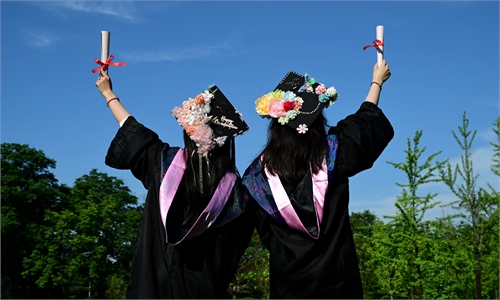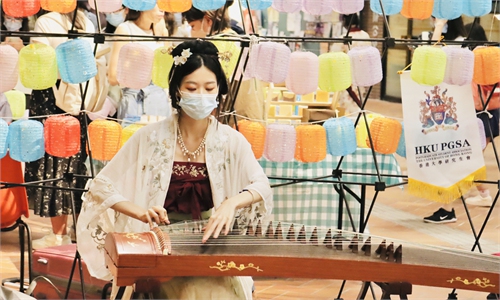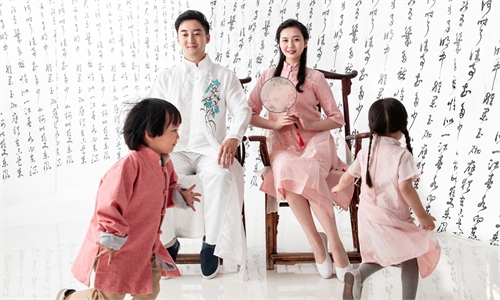ARTS / CULTURE & LEISURE
Hanfu craze: Gen Z revives traditional clothing
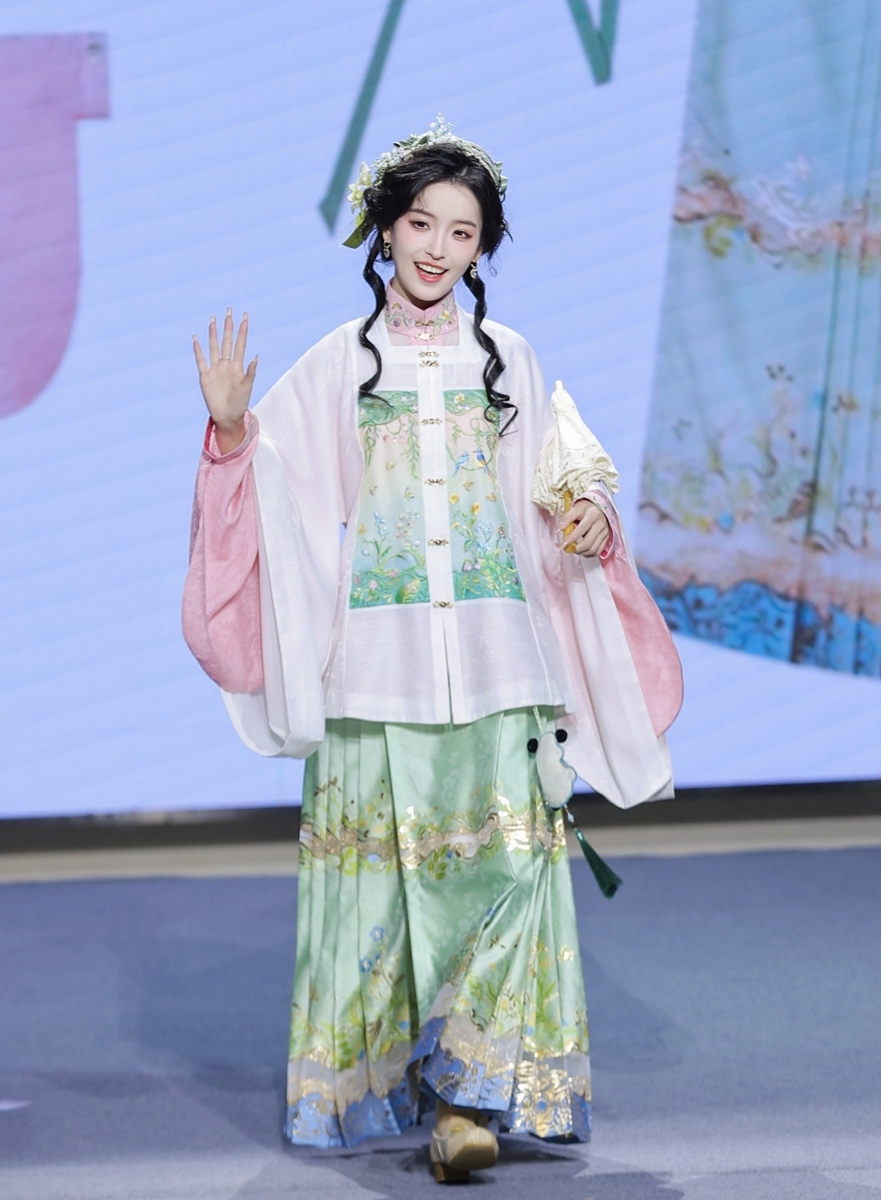
A performer dressed in Hanfu at the 2024 National Hanfu Festival in Hangzhou, East China's Zhejiang Province Photo: Courtesy of China National Silk Museum
Mamianqun (the horse-face skirt), beizi (a traditional Chinese outer coat with loose and long sleeves), baidiequn (hundred-fold skirt)… In recent years, traditional Chinese clothing has become a fashionable choice for many young people. No longer limited to photo shoots, weddings, or special events, Hanfu (the traditional attire which used to be worn by Han Chinese) is now seen on the streets, in daily commutes, and even at work. This trend has spurred a boom in traditional clothing consumption and fostered the rise of cultural events like China Hanfu Day, local Hanfu festivals, and traditional clothing exhibitions, breathing new life into thousands of years of cultural heritage.It's fair to say that the Gen Z (typically those born between 1995 and 2009) has played a key role in this traditional clothing craze. They cherish, embrace, and reimagine tradition, showcasing a confident, trendy, and open-minded image of Chinese younger generation.
Statement of confidence
In a Hanfu styling salon in Yanta district in Xi'an, Northwest China's Shaanxi Province, changing clothes, wearing makeup, doing hairstyle, Zhang Jing is waiting to transform from a white-collar worker in the city into a "Tang Dynasty [618-907] princess." Afterward, she plans to visit the Great Tang All Day Mall (a landmark pedestrian street with historic blocks for sightseeing, as well as trade and cultural facilities) f1or a time-travel experience.
Zhang, from Shijiazhuang in North China's Hebei Province, was born after 1995. Like many of her peers, she loves Hanfu and often participates in Hanfu-themed events during her college years.
To her, Hanfu is not only a symbol of history and culture but also of fashion. Recently, the mamianqun has become popular, and Zhang bought a black and a gold version, describing them as "simple and elegant, suitable even for work." After watching the classical dance program Palace Banquet in Tang Dynasty in 2021, she planned a trip to Xi'an to experience the full Tang-style attire.
Entering the Hanfu salon made one feel like stepping back in time. The shop mainly features Tang Dynasty styles, with a few Song (960-1279) and Ming (1368-1644) dynasties pieces as well. "The weaving techniques, cuts, colors, and makeup that accompany Hanfu are steeped in cultural significance. Wearing Hanfu, I feel like wearing a piece of traditional culture," said the shop owner, Shuangshuang.
Shuangshuang, also born after 1995, was once a kindergarten teacher. She was captivated by Hanfu when she first encountered it.
"The more I learned about Hanfu, the more I realized its deep cultural significance." She bought many books, such as Illustrated Chinese Traditional Clothing, Color Making: The Color Aesthetics of the Chinese People and Chinese Traditional Color Matching Manual, to make up for the relevant knowledge. She even visited the China National Silk Museum in Hangzhou, East China's Zhejiang Province to see the Ruyi Coral Pattern Pleated Skirt (a traditional Chinese garment unearthed from the Song Dynasty tomb in De'an, East China's Jiangxi Province) and went to see the Ancient Chinese Clothing Culture Exhibition held at the National Museum of China in Beijing to gain a basic understanding of typical clothing, accessories, and makeup from different historical periods.
"Throughout the history of Chinese civilization, clothing has been a vital part of material life and a reflection of societal values," said Bian Xiangyang, vice chairman of the China Fashion Association. From the simple elegance of the Qin (221BC-206BC) and Han (206BC-AD202) dynasties to the luxurious sophistication of the Tang Dynasty, from the scholarly refinement of the Song Dynasty to the intricate beauty of the Qing Dynasty (1644-1911), Chinese clothing culture has evolved over millennia into a harmonious and inclusive system of aesthetics.
Associate Professor Han Dan at Northeast Normal University in Northeast China's Jilin Province, has long studied the "Hanfu craze." She noted that, broadly speaking, Hanfu refers to all traditional Chinese clothing. Enthusiasts often consider 2003 as the year Hanfu began its resurgence, sparked by an ordinary power plant worker who wore Hanfu on the streets of Zhengzhou in Central China's Henan Province. Since then, Hanfu enthusiasts, scholars, and businesses have collectively fueled the trend's growth.
"The Hanfu craze is driven by multiple factors," Han explained. "It stems from China's rapid economic growth, which has enriched both material and spiritual life, as well as strong national support for the preservation of the traditional culture. Gen Z, who grew up during a time of prosperity and strength, feel a strong affinity and love for traditional culture."
Seeing the business opportunity behind the Hanfu trend, Shuangshuang decided to open her own store. During the recent National Day holidays, the shop saw an influx of customers eager to try on Hanfu. "The peak flow is coming soon," she said as she tidied the makeup counter and glanced outside. If the customers come in around 4 pm, just in time for a night tour of Chang'an (the old name for Xi'an in history).
After her transformation, Zhang was stunned by her look as a "princess" but worried it might draw too much attention. Her concerns quickly vanished when she stepped onto the street and met several "princesses," "imperial consorts," and "young scholars." The exquisite clothing complemented the traditional architecture, making them appear as if they were wandering ancient China.
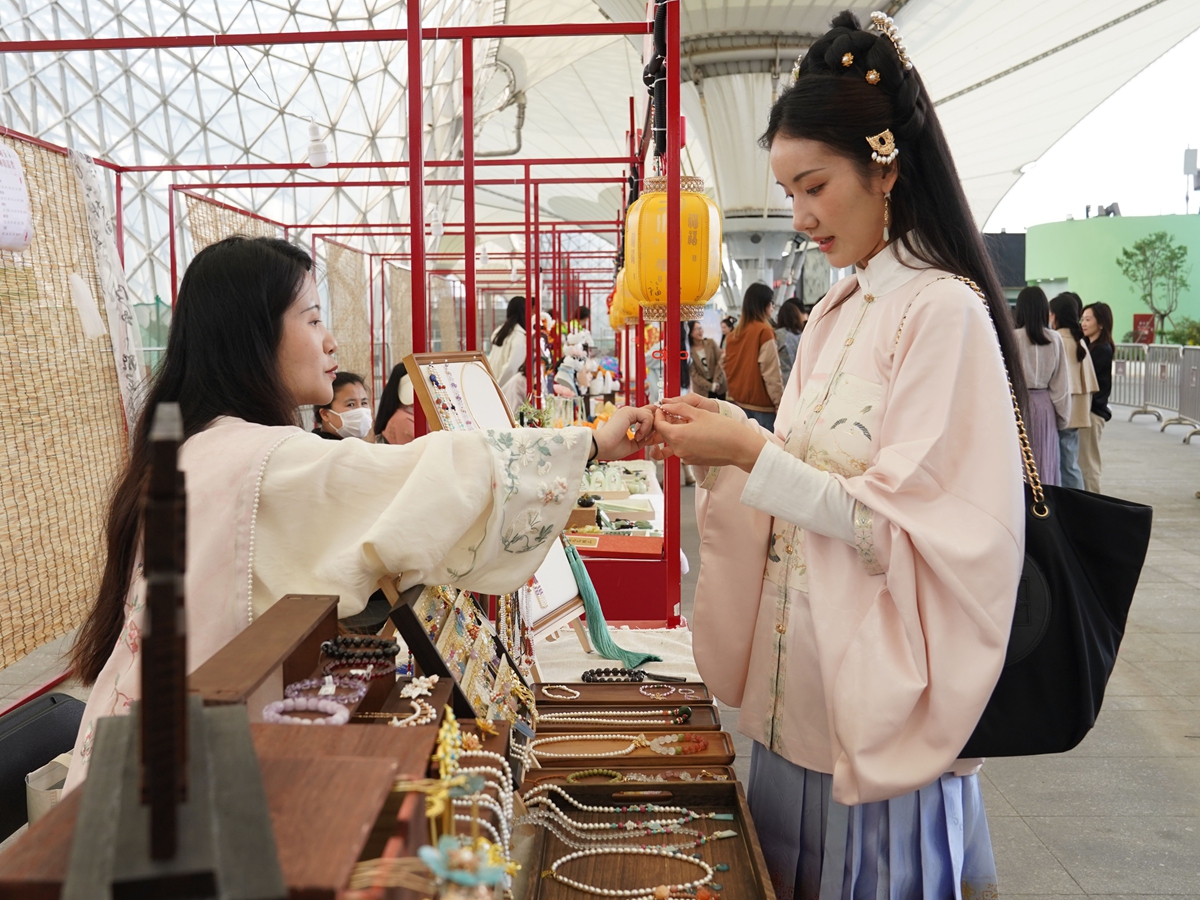
A Hanfu enthusiast selects accessories at a Chinese national style market in Shanghai. Photo: Xinhua
Personal expressionVOGUE magazine commented on the Hanfu trend, stating "the movement is being led by China's fashion-conscious youth."
Cui Wei, a professor at Beijing Institute of Fashion Technology (BIFT), believed that the profound culture of traditional clothing satisfies young people's desire to embrace their heritage and seek new aesthetic experiences and fashion styles.
"Chinese traditional clothing, with its long history, rich traditions, and unique system, embodies deep cultural values, aesthetic principles, and national characteristics, such as harmony between humans and nature, yin-yang balance, ritual propriety, auspicious symbolism, and symmetry. Wearing traditional attire demonstrates cultural confidence and showcases unique cultural temperament," Cui said.
For instance, mamianqun, a distinctive traditional style, has gained popularity in recent years. According to the "2024 Douyin E-commerce Women's Consumption Trend Report," orders for mamianqun increased by 841 percent year-on-year in 2023.
In fact, mamianqun has been on the Hanfu market for years. Why have they only become widely popular recently? Dai Yuqing from BIFT attributed this to the media promotion of traditional culture, the successful modernization, and the accessibility and affordability of traditional attire.
"Besides mamianqun, other popular styles include modified beizi from Song Dynasty clothing and Mandarin collars from Ming attire," Dai noted. Today's Hanfu merges traditional culture with modern fashion.
Han also observed that young people who are passionate about traditional clothing usually have clear preferences when it comes to the styles, types, and designs they choose. Some even create and customize their own outfits based on personal tastes, expressing their understanding of clothing culture, traditional culture, and fashion culture. This aligns well with the Gen Z characteristics of diverse interests and personalized self-expression.
In this sense, Gen Z is both the main force of preserving traditional clothing and the driving force behind its revival. They continue to inspire designers to draw from traditional elements and innovate.
Previously, a mamianqun, displayed at the Ancient Chinese Clothing Culture Exhibition held in the National Museum of China, became a viral sensation online, prompting many businesses to create replicas. Wearing a mamianqun to take photos at the mamianqun became a popular activity among young people. Since 2018, the China National Silk Museum has held the annual National Silk and Hanfu Festival, attracting numerous Hanfu enthusiasts and businesses.
The National Silk and Hanfu Festival in April 2024 featured two main themes: "Ancient Charm" and "New Trends." Highlights included "Hanfu Night" and a forum on Hanfu culture, which focused on the modernization of Hanfu. Additionally, Hanfu performance groups presented a themed runway show, "Ancient Charm in Modern Style," blending traditional Hanfu with contemporary fashion to showcase the limitless potential of traditional clothing culture.
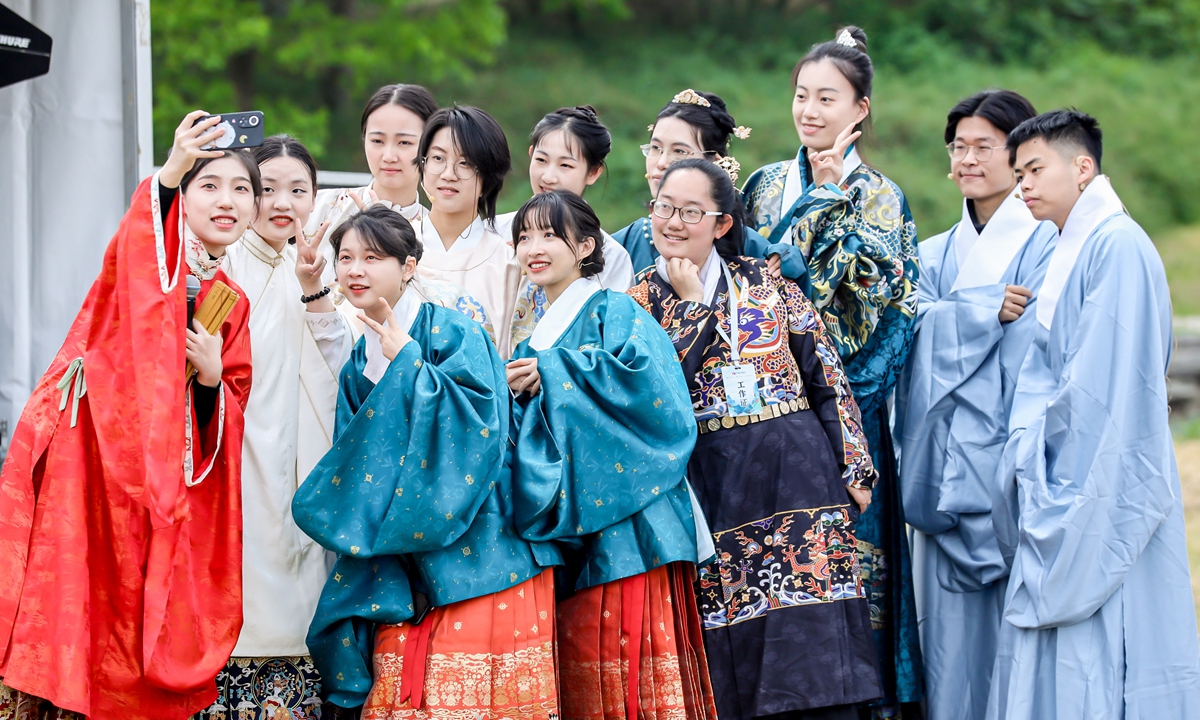
Hanfu enthusiasts take photos at the China Hanfu Day event in the Old Summer Palace, or Yuanmingyuan, in Beijing. Photo: Courtesy of the management office of Yuanmingyuan
Rise of China chic showcases youth's powerAs a vital part of China's rich cultural heritage, the traditional clothing culture embodies Chinese etiquette, philosophical beliefs, aesthetic tastes, and ways of life. It also has a broad influence, extending into literature, music, fine art, dance, opera, and other cultural forms.
Through the bridge of traditional clothing, more and more young people are being introduced to and falling in love with the charm of Chinese-style aesthetics and ancient Chinese traditions.
In April, the Huazhang Hanfu Society at Beijing Normal University held two sessions of the "Hanfu Makeover for Beginners" event. At each session, one student was selected from those who shared the event online. Yang Shiyu, a law master's student from the class of 2023, was the lucky participant of the first session. Dressed in a Tang Dynasty high-waisted skirt, wide-sleeved robe, and a Ming Dynasty beizi, and styled with matching makeup and hair, she took two sets of photos. After the photos were shared on the Huazhang Hanfu Society's WeChat account, more students on campus and beyond, gained an appreciation for the beauty of traditional clothing.
Founded in 2011, the Huazhang Hanfu Society gathers Hanfu enthusiasts among undergraduate, master's, and doctoral students at Beijing Normal University, with 94 registered members. According to current president Zhang Runyao, the society is divided into five interest groups: Qingni, Zhuohua, Wansu, Liuyu, and Hanyan, covering areas such as Hanfu design research, classical dance, and traditional handicrafts.
"We frequently collaborate with the Shaoxi Traditional Chinese Music Society, Songfeng Chinese Musical Instrument Society, and Nanshan Poetry Society on campus to host traditional cultural events, combining Hanfu displays, educational workshops, guqin (a seven-stringed plucked instrument, one of the oldest Chinese musical instruments) performances, tea ceremonies, and poetry recitals. These events are very popular among students and have attracted many international students," said Zhang Runyao. Hanfu enthusiasts generally show a strong interest in Chinese traditional culture.
"Wearing traditional clothing often involves learning and emulating ancient rituals and customs, such as tea ceremonies and playing the guqin. This allows young people to gain a deeper understanding and experience of the rich essence of Chinese traditional culture, immersing themselves in its influence," said Han.
In June, Dai and her colleagues visited Hepingjie street in Chaoyang district, Beijing, to present the evolution of traditional clothing in a fun and engaging way for local children. They aimed to help kids appreciate the aesthetics and wisdom behind ancient attire.
"Since 2017, under the guidance of Professor Jiang Jinrui from BIFT, we have been dedicated to training professionals in Chinese traditional clothing and promoting cultural education. We have also incorporated Hanfu into academic lectures. Now, we hope that by organizing traditional clothing events, we can plant the seeds of traditional culture in the hearts of children," said Dai.
